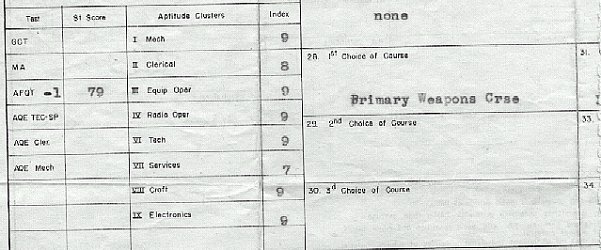OLD SARGE
Bud Farrell
Sergeant Heininger was a 42 year veteran of the Army Air Corps and the more recent Air Force (1947), whose only family was the Air Force, and he had "hash marks" (service seniority stripes) long enough to exceed his stubby sleeve length, and he in fact looked like the Bulldog of a Sergeant in the latter day Beetle Baily Comic Strip! He could not have stayed in the Air Force that long in later years but he had no place else to go, and found his family niche in life harassing "casual squadron" recruits , those just out of Basic Training, awaiting assignment to one of the numerous technical training schools at Lowry Air Force Base, everything from Accounting, Finance, Aerial Photography, Radar Maintenance and Repair, Armament (weapons and bomb loading), and Remote Control Turret (RCT) School, the prerequisite electronics school for Gunnery School!
Sergeant Heininger frequently made "raids" on the Casual Squadron barracks, in off duty hours, to drag recruits away for any "detail" he could dream up, any chore he could find for anyone appearing too comfortable ... "idle hands were the Devil's play toy"! Ol' Sarge was the epitome of "if it doesn't move, paint it", or only wanting "to see assholes and elbows" policing the area for cigarette butts or any other litter. ( To the day I quit smoking my 3 to 4 packs a day 22 years later, I STILL very subconsciously "field stripped" every cigarette I ever finished when outdoors!) If anyone spotted Ol' Sarge coming across the squadron compound, there was a blood curdling scream ... "HEININGER'S COMING!" and a mass evacuation of fleeing recruits ran out the opposite end door of the barracks and disappeared into sanctuary of the P.X. for a coke, a 3.2 Beer ... ..anything but a detail! He was invariably frustrated AND infuriated as the anonymous thundering herd of olive drab fatigues faded in a cloud of dust toward the PX where he could NOT identify or claim them in their off duty hours once out of the squadron confines. One day I was caught off guard by one of his "hostage takings" and could only make it as far as a phone booth that was in the barracks and my only escape was to jump in the booth, hold the receiver to my ear, other palm turned up, and plaintively look up at him and say "LONG DISTANCE". His jowls were trembling at his failure to capture an "enemy"!
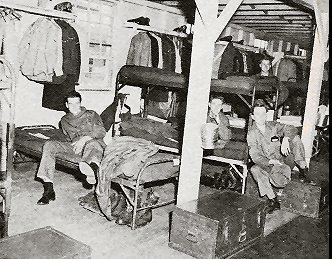
Photo from Paul Savko's Gunnery School 1952 "Yearbook"
The above photo reflects the stark "d?cor" of any open bayBarrack ... with the typical "Dust Cover" made bed, with the thin mattress on metal springs, shoes properly aligned beneath, clothes hung on open rack at wall, uniforms, shirts, etc, hangers properly spaced at "3 fingers apart", foot locker facing open bay. Note the # 10 "butt Can" on the post above foot locker ... half filled with water, an efficient ash tray and extinguisher, emptied daily, smelled awful! And this picture must have been taken on a Saturday afternoon or Sunday ... all that "lollygaggin' goin' on! This was NOT what was meant by a "CASUAL SQUADRON"! Note the lack of any chairs ...
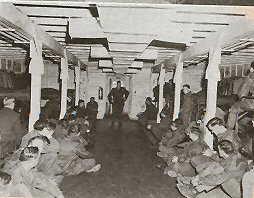
Paul Savko's Gunnery School 1952 "Yearbook"
At morning roll call the daily list of names and assignments was read and finally included mine - to a school other than that for which I had been tested, qualified, and selected. The AFSC ( Air Force Specialty Code or MOS -Military Occupational Specialty) tests ran a gamut of career fields from technical schools to "services", which could have meant cooks, motor pool, clerk typist, and any number of other fields which I thought I had done my very best to avoid by rigging low scores in these aptitudes! I had had an overwhelming determination to become a Gunner ever since an older friend and fishing partner, Ed Jefferis, had returned from WW II in 1945, having completed a European Combat Tour as a Flight Engineer/Top turret Gunner in a B-17 (and having shot down 3 German ME-109's) ... ..my boyhood idol and very reason for enlisting and wanting to be an Aerial Gunner! What I didn't know then though, is that his experiences prevented him from EVER getting back into ANY type of aircraft EVER again ... never ever once!
At the end of roll call I approached the jowely - not jolly - First Sergeant and modestly but firmly protested that I was supposed to go to RCT School, not that which I was on the list for. I was in such a rage of disappointment that I now don't even remember what the incorrect school assignment was, just one that I was not going to accept in lieu of becoming a gunner! He told me in no uncertain terms to get back in formation and that I was going to the school for which they had read my name. Upon dismissal of the formation I went into the Squadron Orderly Room and was again confronted by the First Sergeant and told him, in accordance with chain of command regulations, that I was formally requesting permission to see the Training Officer. "Permission denied!" ... he refused and very loudly told me to get out, and I again told him that if I didn't get to Gunnery School I would go AWOL (Absent Without Leave) since this was the very reason for my enlistment! As the volume of our argument amplified, a short and older Training Officer came out of an office demanding to know "what's going on out here?" I started to explain as the Sergeant tried to cut me off ... the Officer said "hold it Sergeant, let him finish!"
After I finished, very emotionally, the Training Officer said "Sergeant, get orders cut for this man TODAY ... for RCT and Gunnery School!" Whew, that instead of a court martial was a big swing ... ..and then I noticed the gold bars of the 2nd Lieutenant, obviously a field commission that he could have gotten only for some extraordinary effort during WW II , a long 6 years or more earlier, and perhaps an even longer 6 years as just a 2nd Lieutenant (perhaps recalled from the reserves), and several decorations and ribbons ... including European Theatre, Victory Medal, Good Conduct, a Presidential Unit Citation, The Air Medal, The Distinguished Flying Cross, and a very unusual uniform adornment for an Officer ... very highly polished Silver GUNNER'S WINGS!! (*)
Aptitude Test Scores - 9 was the highest score, and I didn't want to be a clerk, cook, or in Motor Pool ... I only wanted to be a Gunner!
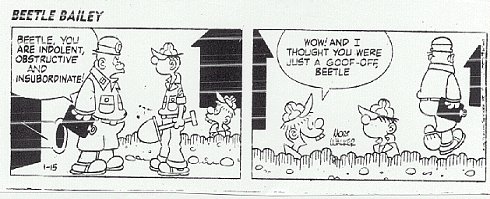 Reprinted with special permission of King Feature Syndicate * Exactly Fifty five years later, in May 2006, I found that the 2nd Lieutenant referred to was Lt. Adam C. White and I hope that this somehow honors him as I did then and do today! |
Lowry AFB in Denver Colorado had to be one of the best assignments in the Air Force and of course getting into the Tech. School of your choice was icing on the cake! After Basic Training in Wichita Falls, Lowry was a dream ... RCT Classes on 'B" shift from 1200 to 1800 hours, very little duty on details, which was a nice word for chores, from policing the grounds to mopping and polishing floors, to K.P. (Kitchen Police if there is anyone left in the World that doesn't know ... and perhaps there are lots that DON'T know now since much in the military has changed to civilian contract labor)!
All classes of all tech schools at Lowry had to "pull K.P.", the resident slave labor at "The Consolidated Mess" ... of which I was never quite sure whether its title described the facility or the FOOD! The Consolidated Mess Hall fed approx. 5,000 Airman at each meal, with a constant ebb and flow of olive drab uniformed trainees going to or coming from "shift" classes, "A" ( 6:00 A.M. to Noon) , "B" ( Noon to 6;00P.M.), or "C (6:00P.M. to Midnight),. Somehow the "C" shift classes were always crazier and louder when marching to and from classes, perhaps because in the dark of night no one could identify offenders!
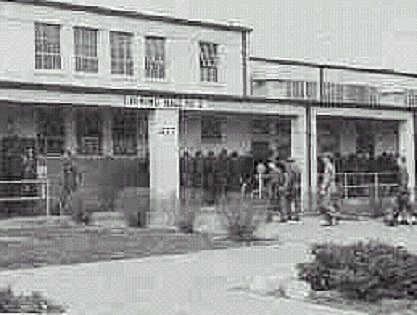
K.P. began about 3 O'clock in the morning and usually lasted ALL day, 'til after the last evening meal was served and cleaned up after, about 8:00 in the evening. K.P. used to be used as a punishment tool but since they had everyone pulling K.P., they had to find punishments WITHIN the punishment ... and these were the dreaded GARBAGE RACK ... and POTS AND PANS! Pots seemingly as big as a Volkswagen , and Pans the size of a desk top! Any misdeed or slackness while on K.P. was under close scrutiny since they always needed these dirty "details" filled ... not a matter of IF, but simply when and WHO!
During one of our regularly scheduled K.P. tours, Rex Parsons from our Basic Training Flight, and eventually the Right Gunner on our Crew, a very quiet soft spoken straight arrow guy from Keokee, Virginia, was assigned during the serving hour to the chow line and giving out cookies ... with the obligatory metal serving tongs, and I was assigned to hand out the little half pint Milk Cartons right next to him ... we certainly couldn't have trusted them to take their own milk carton! He had been told that there were "not enough cookies to give seconds so only TWO cookies per person, NO MORE!" As the long multiple serving lines and the noise of a few thousand kids grew, one Airman came back to Rex for "More Cookies!" Rex said "Sorry fella, the Mess Sergeant told me no seconds there aren't enough cookies!" "God Damn it, give me some cookies!" "I'd like to but ... ." ... and about that time the wise guy reached in the cookie tray and grabbed a handful ... .and Rex desperately tried to fend him off ... with the cookie tongs! And the scene was so bizarre, two grown men fighting each other off over a couple of cookies, that I started to laugh out loud and uncontrollably ... 'til the Mess Sergeant was there to find out what the ruckus was about. Rex started to explain, and the more he explained the funnier it became and the Mess Sergeant, as ugly as a side of beef, as all Mess Sergeants seemed, said " What the hell's so funny to YOU?" Of course by then I already knew we were a target destined for something ... most likely a very long day at hard labor! "You on the cookies ... back on " POTS AND PANS!" Still unable to control my laughter ... "YOU'RE OUTA HERE WITH HIM!"
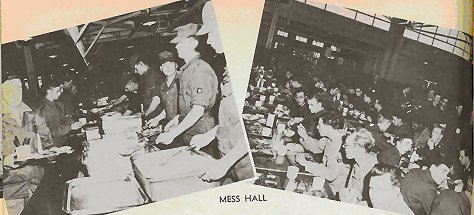
Photo from Paul Savko's Gunnery School 1952 "Yearbook"
The POTS & PAN Rack looked something like the side of an Aircraft Carrier, so large that there were steel ladders up the sides to at least 10 or 12 feet in the air ... with seemingly THOUSANDS of cookie trays and pots, and pans, all clean but very capable of revealing a finger smudge of grease ... IF you tried hard enough ... we were doomed and resigned ourselves to an "ALL Nighter" of washing and rewashing and re-rewashing! At about 11 that night we were released from K.P. to return to our barracks and we were so punchy that I was STILL laughing about the day and Rex, defender of Democracy ... and COOKIES!
Just fifty years after this incident, I received an email joke that somehow seems to relate: Children were lined up in the cafeteria of a Catholic School for lunch. At the head of the table was a large pile of apples, upon which the supervising nun had placed a note, "Take only one, God is watching". Moving through the line, to the other end of the table, there was a large pile of chocolate chip cookies ... upon which a boy or girl had placed a note ... "TAKE ALL YOU WANT, GOD IS WATCHING THE APPLES!"
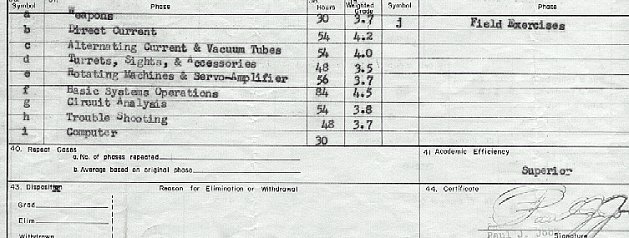
Some things, really important things, remain with you forever ... and earlier in our K.P. day I had witnessed the Mess Sergeant almost take apart a trainee who had the temerity to rest his weary bottom just against the edge of a table between the repeated sweepings and moppings of the huge concrete floor ... and I have never forgotten his screaming this Poetry classic!
| "Tables are made for glasses, not asses, When your ass turns to glass, sit on it!" |
| Remote Control Turret Class or Barrack | |
| Frank Farrell- Aldan, Pennsylvania Audrey Bassett - Florida Tom Furlong - Whitemarsh, Pa. Floyd Gentry - Beloit, Kansas | Jerome Hatch - Canada Donnie Hoskins - Wink, Texas Rex Parsons - Keokee, Virginia John( Putsock) Regallo |
On Labor Day Weekend of 1951, while in RCT School at Lowry AFB in Denver, I had the opportunity to visit a friend of my Mother's, an Ann Kreider, who had worked in the Baldwin-Lima-Hamilton Army Tank Shop in Eddystone, Pennsylvania in 1950 with my Mom, and whose officer husband had been recalled from the Air Force Reserve for the Korean "police action", and was stationed at Pedersen Field in Colorado Springs. Labor Day Weekend was the weekend of the Pikes Peak Hill Climb, the auto endurance race up that rugged winding dirt road and a real treat given me by the Kreider's ... perhaps 'cause they didn't know what else to do with a teenager guest ... an enlisted man at that! I remember fondly their very gracious treatment of me as host and hostess of virtually a complete stranger!
Below is the Continental Airline Ticket for my flight from Denver to Colorado Springs on September 3rd. 1951 ... an "exhorbitant" $ 4.60 !
Something else Mom saved from my letters!
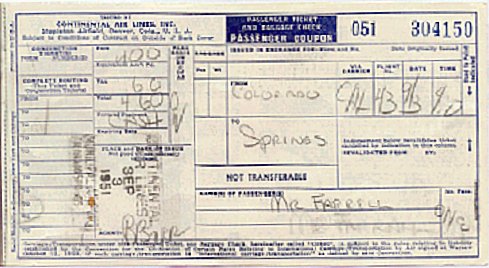
While in either RCT School or prior to that in the "casual squadron", awaiting tech. school assignment, there was a fairly strong rumor of the Squadron Commander, a Captain Max Rummins, who had supposedly been permanently banished from flight status as a hot F-51 Mustang pilot to the nether regions and shame of Training Command "Siberia" for a daring and legendary feat of having flown an F-51 through a Hangar, in one large open door and out the other, with a spectacular concluding spiraling barrel roll climbout. Lord knows even the name "MAX RUMMINS sounds like something out of a Red Baron Story! Maybe it is worth doing just one unforgettable thing in a lifetime ... at any cost! "Max VAROOMins"!
On May 4th, 2006 I received my very first validation or confirmation that there ever really actually WAS a "Max Rummens". I received an email from Norman Stein of San Jose, California and his order for 3 copies of NO SWEAT for him, his brother Jack Sergeant (see THE GENERAL SITUATION narrative), who was also in the Air Force and on Okinawa in 1952 (now of Kutztown, Pa) and a third copy for Norm's son (an ex-Army Armored/Tank crewman), in Shelton Washington. Having made a followup call immediately, I was thrilled that Norm had found my name on the Internet in a "B-29" search, and in fact had followed my Air Force career path or "trail" by just a few months.
Norm was even more familiar with Max Rummens than I ... his mother had traveled to Denver's Stapleton Field in early1952 to visit her son who was then in the Munitions section of The Armament Tech School, and had just volunteered for Gunnery school upon a special call for volunteers. The time line of this would have placed it virtually within a few days of the disastrous B-29 -North Korean Namsi Airfield, "BLACK TUESDAY" mission of October 23rd 1951, with the loss of several 19th Bomb Group and 307th Bomb Wing ships and as many as 55 crew members. Newspaper clippings just a little further along in this book reflect that the urgency and priority of the situation required the cancellation of Christmas leaves for the Gunnery School students.
Norm's Mom, on arrival at Denver's Stapleton Airport, called to his Squadron Orderly Room and somehow got Major Max Rummens on the phone and he very graciously offered to have an Air Force Staff car pick her up and went a step further in inviting her and her son for dinner at the Lowry AFB Officers Club. Having met Norm briefly and spotting that he did not have even the single stripe of a PFC (Private First Class) *, which was virtually automatic out of Basic Training. "Max" asked Norm what had cost him the stripe ... a minor offense of trying to leave the base without the correct papers with him. Max advised Norm that he was calling his own Squadron Adjutant and having orders cut immediately to have the rank and stripe reinstated by dinner time that night ... and a good time was had by all!
For all too many years, I had begun to doubt my own memory related to so many Max Rummens' stories, even from so many beside myself ... until I received on 6/1/06 from Paul Savko of the 307th Bomb Wing, his copy of his Lowry AFB Gunnery School "Yearbook for Class 18 in 1952", the likes of which I had never seen before but now wish that I had had through all these years. There in all his glory is a photograph of the actual Major Max Rummens, Commanding Officer of the 3436th Student Squadron ... and even the caption in the yearbook describes him as Major. M.M. (Mad Max) Rummens.

Photo from Paul Savko's Gunnery School 1952"Yearbook"
Major M.M. ("Mad Max") Rummens
Gunnery School Commanding Officer
and the "AIRMEN'S AIRMAN"!
And John Moran - "Tangalelay " of our Gunnery School flight and NO SWEAT- remembers while going through RCT School, a Captain they called "Carbine Carl" for the single decoration he wore ALL the time, a "Marksman Badge", and that whatever position he held, he considered to be of very great authority. While legitimate and worn by Marines 'cause they WERE marksmen, it was seldom if ever worn by even the few in the Air Force who may ever have earned it! I just found out a few years ago from updated service records that I had been qualified as "Marksman" with the M-1 .30 caliber Carbine and the .45 Pistol but had never known it 'til just then ... so I may just get one ... and wear it around my Marine Corps friends! That and my GOOD CONDUCT MEDAL! HA!
Anyway, "Tangalelay" (John Moran) says as the irreverent bunch that they were, they would conduct "guerilla warfare" against "Carbine Carl" and after many episodes of company punishment, he finally seemed to lose all semblance of sanity. "Carbine Carl" appeared in their barrack one day, adorned with his lone decoration and said - among other things - that those who were headed to Gunnery School after RCT graduation, were "paid killers and doomed to death". This tirade may have been the precursor to the experience of Norm Stein, as follows.
Norm Stein further relates - confirming " Tangalelay" - that during a very early and bitter cold January morning roll call formation, after a long quiet interlude after the "All present and accounted for SIRS", what started as "a low angry growl", becoming a shout ... "YOU ARE ALL NOTHING BUT A BUNCH OF HIRED KILLERS" , and that they should all search their individual consciences "before committing further destruction in this God awful war"! A similar second morning had all wondering who could possibly have put this tightly wound character in charge?
On the third morning a different voice apologized for what the roll call formation had been put through in the two preceding days and that the group were NOT going to be hired killers but simply defenders of their aircraft in combat ... and Major Max Rummens told them how proud he was of them in their volunteering for very difficult duty futures. Major "Max" ended by announcing that the offending officer "had confusing beliefs and was being replaced immediately" as evidenced by his absence! And now I must speculate, and truly would like to believe, that this may have been a seriously disturbed, or certainly disgruntled, Reserve Officer who may have been recalled after having served honorably in WW II, gone home to restart family and career, only to be called up once again, as were so many during the Korean War. Norm Stein says that not only could Max Rummens FLY a MUSTANG, he WAS one ... indeed a great Airman at any rank!
Sadly, Norm has additionally reported that he had received information many years ago that Major Max Rummens - apparently reinstated to flight statu by the Air Force - had been killed in the flameout and crash of a jet fighter somewhere in Alaska. VAROOOM again Major "Max" Rummens ... you have flown into OUR hearts and memories with your gracious good nature and marvelous character ... without ever having had to fly through a hangar!
I was reminded too that when I made Buck Sergeant in mid-December, 1952 just before returning to the states and a 30 day leave in January in Philadelphia, and its winter climate, like Norm Stein, it had never occurred to me that I had NOT gotten the new set of 3 stripes onto my summer uniforms and I was reprimanded during a SAC inspection in warm Tucson, Arizona for not having them on ... and told to get them on or lose them ... I still have the Khaki shirt and those stripes ... hurriedly and HALF GLUED! " SEW WHAT"?

GLUED OR SCREWED!
A GUNNER'S LAMENT - The 18 WEEK MAN"S PRAYER
I pledge allegiance to the central fire control system and to the General Electric Company for which it stands, one circuit, inconceivable, with malfunctions and reversals for all.
PREAMBLE TO A WIRING DIAGRAM
We the engineer's of the General Electric Company, in order to make more money, establish tech schools, insure jobs for our employees, provide a means of defense for the B-29 and promote general warfare between the men who fly and those who must fix them, do hereby ordain and establish this electrical nightmare for the Army Air Forces of the United States of America.Above from Historic Wendover AFB (Utah) Museum Collection
(Courtesy of Thomas Peterson)
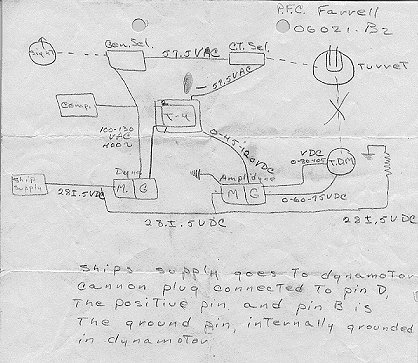
Above schematic diagram from RCT School test
"Historic" Farrell- Notes Collection

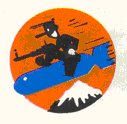
Lowry AFB Logo
THE WHOLE NINE YARDS
In the 1990s I read in a Gunners Association Bulletin that the February 1999 Issue of American Rifleman had stated that the expression "Whole Nine Yards" came into use with the introduction of machine guns mounted on aircraft during World War I, and most machine guns were fed from belts held in drums or boxes. The maximum capacity of a drum or box held 350 to 400 rounds of rifle -caliber ammunition in a belt approximately 27 feet OR 9 yards in length. A pilot returning after having expended all of his ammunition had fired the "whole nine yards"! And now we were ready to put together the "whole nine yards" of our training!
Upon completion of 18 weeks of RCT (Remote Controlled Turret) School, we immediately phased into Gunnery School, an 8 week program of putting together the information we had learned about Turret Systems Electronics, the Browning .50 Caliber Machine Gun, and the additional procedures and responsibilities we would have as Gunner/Scanners, required to do engine pressure checks in preflight, visual checks during flight, flap and gear reports, enemy aircraft identification and many other subjective determinations regarding the success of our mission, simply to carry a bomb load to the enemy and return to do so again on many other days.
The excitement and realization that we were "finally going to get to fly" was brought home when we were scheduled for the "Altitude Chamber", a session designed to brief us on the proper use of the oxygen mask in depressurized atmospheres at altitude. The B-29 was the first World War II Bomber to have a pressurization system but was of course vulnerable to sudden decompression due to damage or other system failure ... and the aircraft was NOT pressurized during a bomb run due to that vulnerability and the possible necessity of fast escape being prevented by internal pressurization holding bulkhead escape hatches closed. (The reality of this great danger is later realized and described in the "Suiho Gauntlet" chapter related to the loss of # 802 BAIT ME, one minute behind us in the bomber stream and just south of the 38th Parallel in South Korea on 9/12/52.)).
Having withdrawn the ground level atmosphere in the chamber, with everyone now on oxygen with masks in place, the instructor explained the symptoms and effects of anoxia or hypoxia, the lack of oxygen. To illustrate the symptoms he got a volunteer to remove his mask and begin to repetitively sign his signature on a clipboard notepad ... very small, sharp and clear initially, but within a few minutes the eyes of the volunteer glazed, and the hand holding the pen was making broad sweeping strokes, totally uncontrolled and beyond the slightest awareness of the volunteer! The replacement of his oxygen mask brought a fast recovery and a group recognition of the subtle dangers always present with the lack of oxygen. Upon completion of this demonstration, and after re-pressurization, the instructor gave us one more lesson ... EXPLOSIVE DECOMPRESSION! With what appeared to be a previously hidden "hay hook", he struck the membrane diaphragm in the bulkhead dividing the pressurized compartment with an unpressurized compartment having an atmosphere comparable to that which would simulate an altitude of approximately 25,000 feet ... a sudden "kick in the chest", a fogging up of the atmosphere within the room, and a mad scramble to get oxygen masks on ... .exactly what the exercise was intended to do!
In addition to classroom sessions, we had several simulated combat flights over the Split Rock, Wyoming Gunnery Range with F-51 Mustangs and F-80 Shooting Star Fighters making gun-camera passes at us in simulated fighter attacks that would be recorded on film for later review and evaluation. Our first B-29 flight was very exciting and "enhanced" with our experiencing an engine fire and failure, and the chase down the runway of the crash and fire crews as we landed ... without further incident. We were soon to learn that that was NOT a unique or even unusual event and we were soon a lot less thrilled with any excitement of that type!
After classes every day in the Armament School Building we always had to clean and wax the floors ... EVERY day! The floors were so highly polished they looked like mirrors. One day one of the trainees, Sandy Kerner, thought we should draw straws and losers do the floors and winners leave for the day, a 50/50 chance of goofing off ... and I said "Why don't we all just pitch in and get it done and all go at the same time!" Kerner took that at as challenge to his idea and started after me and I went for him when I saw what was happening ... but we were broken up by our classmates and all stayed to finish the detail! This was the only NEAR fight I had in the service and of course we both would have gotten in trouble regardless of who started it! (Three months later Sandy was killed in a mid air collision of two B-29s near Randolph Field, San Antonio, Texas.)
One Saturday in the Fall of '51, Rex and I went over to Base Operations to see if we could get a "joy ride" with some Pilot who had to get his required monthly 4 hours flying time to collect his Flight Pay. We checked out Parachutes and ended up getting a ride in a C-45, a small twin engine Beech, and spent about 4 hours circling in the same pattern over the football stadium at Boulder, Colorado ... while one of the two pilots watched his Alma Mater, Colorado University, while listening to the game on VHF Radio. Sitting in the back on a bare metal deck , bouncing around in the ever present turbulence of the front range foothills of the Rockies left a great deal to be desired and serious doubts about our futures!
On an early November Sunday, our class was scheduled to fly our last Lowry training mission, which included the full gamut of Gunner /Scanner preflight responsibilities of pressure checking engines and all other flight systems with a Training Command Flight Crew, composed of Aircraft Commander, Pilot, Flight Engineer and two Gunnery Instructors, none of whom we knew or had any relationship with. Our pressure check of one of the engines gave a very real and strong odor of high octane gasoline, and further manual exploration feeling blindly around and behind cylinder heads etc., finally produced the cold wetness of evaporating raw gasoline. The Aircraft Commander was very upset that there was going to be a repair delay caused by our thoroughness ... which turned out to be a cracked injection pump, an extremely serious malfunction causing a major fuel leak that clearly would have resulted in serious, if not extremely dangerous, in-flight problems with a potential major fire threat.
The Aircraft Commander was angry that his Sunday and dinner were interfered with and he was in a great rush to do everything to get the mission over early so he could get home to his family, a not unenviable desire! We completed our preflight and the ground crew made the change of the pump and we were soon on our way, maybe an hour or two late, flew the mission and returned without further difficulties other than having to respond to an angry A.C. whose mind and heart were at home and at the table with his family. Shortly after our December 5 th arrival at Randolph Field, San Antonio, just after our leave between assignments, we heard that three weeks after our last Lowry flight, on November 7th, on December 3 rd, the same Aircraft Commander crashed a B-29 on landing approach into a residential neighborhood of Aurora /Denver, Colorado just off the end of the Lowry Runway, reportedly with the loss of several lives ( 8) and his partial loss of fingers, facial lacerations, and internal injuries, although he apparently survived the crash. Miraculously no civilian lives were lost in the demolished upscale neighborhood. Cause of the accident was reported as loss of at least one engine and perhaps another failing during their final approach to Lowry.
| Training Crew of B-29 Aircraft # 44-61797 Lowry AFB, crashed Dec.3, 1951 Capt. James W. Shanks - Aircraft Commander- Major Injury Denver Civilian Resident/Housekeeper Mrs.Murphy Tinsley - Major Injury * On April 9, 2005, I received a letter from Walter Laute of St. Louis, Missouri, who had read NO SWEAT and related that at Lake Charles AFB in Louisiana in June 1952, he was assigned to a training flight crew with Aircraft Commander Captain Shanks and was told prior to the flight about Captain Shanks B-29 crash at Lowry AFB in December 1951, just six months before. This is the very first information that I have received advising that Captain Shanks did return to active flight duty after his crash injury recovery. What a web of tales and memories of others my writing NO SWEAT has brought!
|
Upon the April 2003 receipt of the 1951 accident report and Denver Post articles regarding this accident, and seeing that the civilian houses that were destroyed were # 80 & # 95 on Eudora Street, that street name rang a bell with me and I just looked up in my li'l "brown Address Book" and confirmed that a girl I took to the movies in Denver, with a nickname of "Dynamite", accurately reflecting her bubbly personality, lived at 209 Eudora Street, one block away, and then in the days of short phone numbers ... Fremont 6667 ... .anyone recognize either?

Somewhat ironically, there was a WW II B-29 with the Nose Art name of "Dinah Might" ... here after making an emergency landing on Iwo Jima on March 4th, 1945 ... and for which THIS and many more B-29 crews owe their lives to the U.S. Marine Corps in the historic and costly taking of this Japanese Island stronghold specifically in order to eliminate the Japanese fighters operating from there in the 1,600 mile route of the B-29s enroute from the Mariana Islands - Guam, Saipan, and Tinian, to Japan ... and as an emergency base for approximately 2,500 severely damaged or fuel short aircraft, and/ or those with severely wounded aboard ! SEMPER FI!
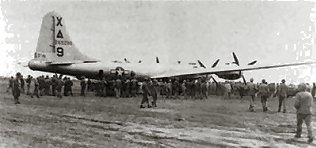
Dinah_Might_at_Iwo_Jima.
This image is in the public domain because it contains materials that originally came from the United States Marines.
Gunnery School and systems were essentially the same for B-26's (being used for lower level bombing and strafing), and B-29's, but there was only one gunner on the B-26 and four for each B- 29 so the opportunities to get into the B-26 were somewhat limited just by the numbers. Several of us desperately wanted to get in B-26's and our only chance was a "lottery" held for each class, names drawn from a hat! Two individuals in our class, Roger Meldahl and Bob Strand, were very close friends and "by chance" BOTH of their names were drawn for advanced Combat Crew Training in B-26's! For many years several of us had wondered about the odds of that happening and one rumor was that they had paid a training instructor $ 10 to have their names "drawn"! In 1994 I found that Roger Meldahl was a member of the 17th Bomb Group Association and found his address and phone number from another member of his group. I called Roger and reintroduced myself through the fog of time, and finally got around to broaching my question regarding the drawing of their names. Roger was very quick and forceful in telling me that "No, it was absolutely not true" that he and Bob Strand had paid $ 10 to have their names drawn ... "It was TWENTY FIVE DOLLARS!"
Roger Meldahl -B-26 Gunner DFC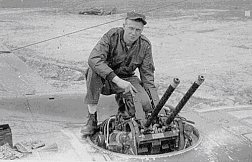 |
And sadly, as a result of my extensive searches for Roger Meldahl, and Bob Strand, I have belatedly been advised that Bob Strand passed away in February of 1966, far too young - surely in his mid thirties - after having survived his probable 50 mission B-26 combat tour in Korea, and now greatly missed by all who remember him ... as did Lucien Thomas, Bob Strand's 13th Bomb Squadron B-26 Armament Assistant and James Van Fleet's Gunner as reflected in his letter to me! *
* Captain James Van Fleet was the son of General Van Fleet, then Commander of all U.N. Allied Forces in Korea, and was lost on his very first combat mission over North Korea. Bob Strand by some stroke of fortune did not fly that mission with his Aircraft Commander that night.
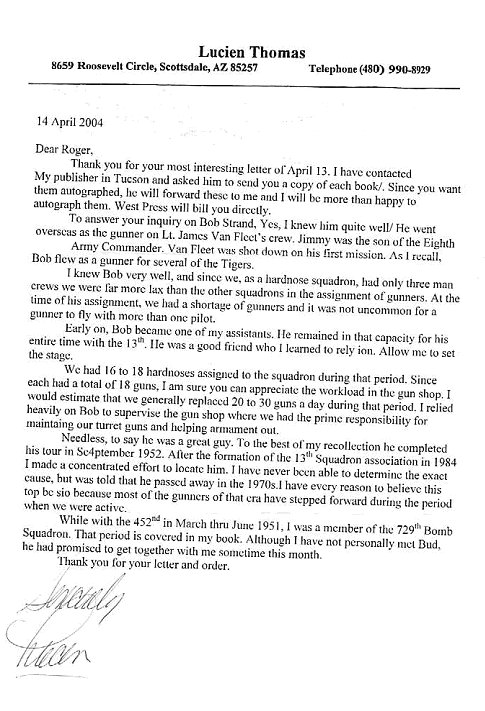
Upon completion of Gunnery School on November 8th, we were given 10 days leave and ordered to report to Randolph Field in San Antonio, Texas for Combat Crew Training in early December. Here we would meet our new Crewmates, the 11 man total of a B-29 Crew. From the JV to the VARSITY!
I have in recent years seen Rex Parsons, Frank Eckles, John Moran, and Angelo Menna, Gunnery School classmates, and our reunions seem like it was only yesterday!
| Lowry AFB Gunnery Class | |
| Bobbie Bouchlas Frank Eckles - Provo, Utah John Eckley Frank Farrell - Aldan, Pa. Jerome Hatch - Canada Philip Kaufman - N.Y.C., N.Y Sanford Kerner - N.Y.C., N.Y. | Angelo Menna - Providence, R. I. Roger Meldahl John Moran - Baltimore, Md Rex Parsons - Keokee, Va. Andy Polzin - Glen Burnie, Md Bob Strand - Minn. Howard Stebbins |
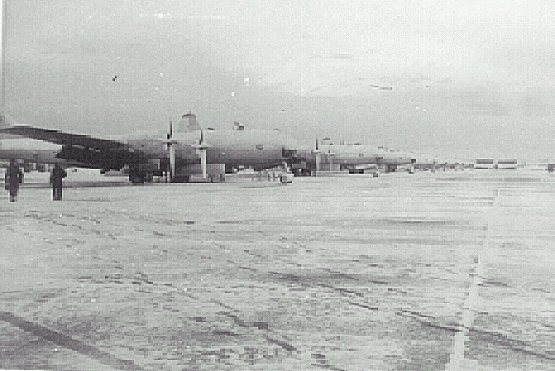
- Farrell Photo -
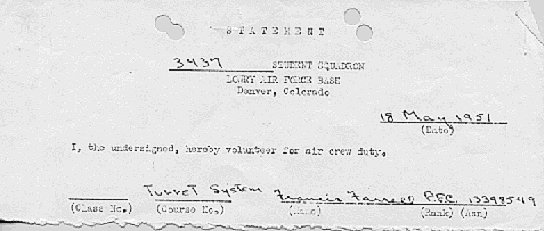
| Gunnery School Flight Angelo Menna, Philip Kaufman, Frank Eckles, Howard Stebbins Andy Polzin, Bobbie Bouchlas, John(Tongolele) Moran, BudFarrell 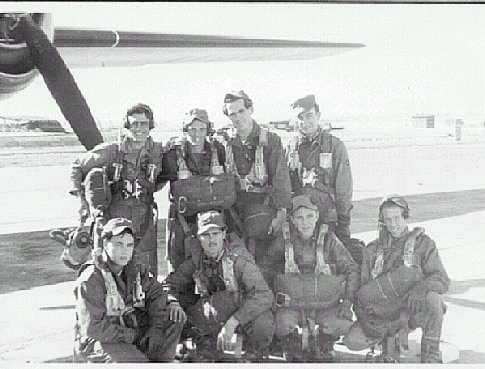 Farrell Photo
|

In 2003, I met via telephone, Scotty McCall of Sherman Texas, who had flown a B-29 combat tour in WW II as Deputy C.O. of the 444th Bomb Group in India and Tinian in 1944 -45, and later flew out of Lowry AFB as an Air Training Command B-29 Aircraft Commander in 1952 while I was there in Gunnery School. Scotty told me about the time that one Gunner of a B-29 gunnery training flight over the Split Rock Range south of Casper, Wyoming had fired prematurely on their entry to the range and struck a cow, the ranch house porch, and a Pontiac ... and I wondered if Scotty had ever had the nerve to have painted on his aircraft the "Kill Symbols" of each ... at very least the Pontiac! (The Cow might have been misconstrued as a "milk run"!)
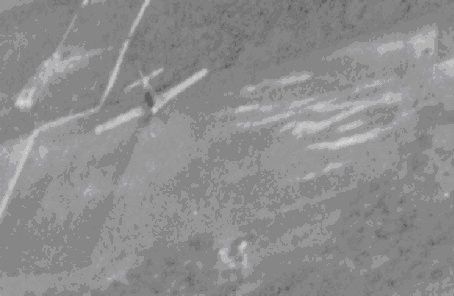
Farrell still photo from Left Blister
I regret that we never got to keep any of the gun camera film magazines we had fired and been graded on since we had some great film of these fighter passes, flown by some hotshot pilots that loved to fly in close, sometimes falling back behind us and then swooping in from 6 o'clock low (the rear and below), and zooming up underneath the ship with very little clearance ... and "bouncing" the B-29 in their prop wash ... sometimes a little too close for comfort ... but fun! "WHUUUUMP!"
Upon completion of our Gunnery School training on November 8th 1951, there seemed to be some urgency in our transfer to Combat Crewup and training at Randolph Field, San Antonio, Texas. What we did not know then or for several more months, is that at the end of October the B-29 Wings operating over North Korea were being devastated by the increased activity of swarms of Mig-15s out of Antung, Manchuria, China ... just 4 miles across the Yalu River from the major industrial targets and bridges along the Yalu River.
On October 23 rd/24th, 1951, the B-29s of the 307th Bomb Wing were then unknowingly in their swan- song of "Black Tuesday" and daylight operations with the loss of 55 crewmembers and 3 B-29s and severe damage to several others with many wounded in a raid on Namsi Airfield in the Mig Alley sector of North Korea. New crews were desperately needed, with additional losses between then and our eventual arrival on June 21st, 1952. The 19th Bomb Group, our new unit, had lost 3 out of 4 ships, with the fourth severely damaged, that they had put over the Kwaksan Bridges on June 10th, 1952, just 10 days before our arrival ... .and that was under the cover of darkness ... things were really heating up and we were JUST IN TIME!
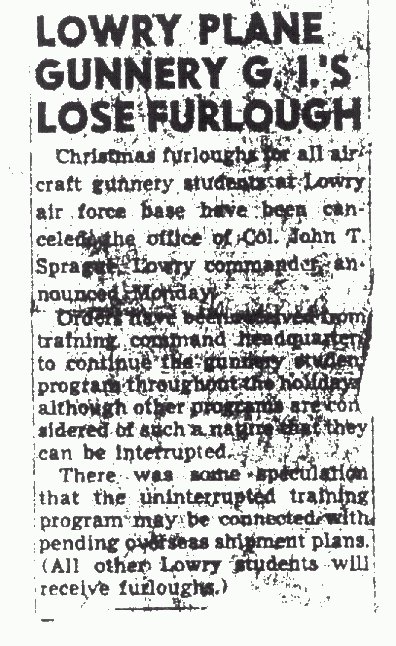
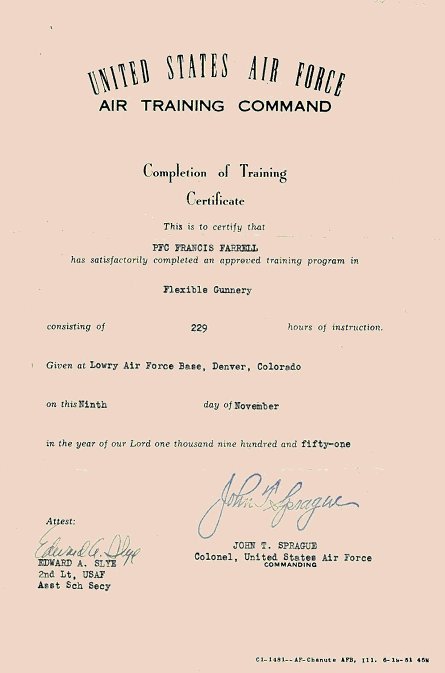
We arrived at Randolph for Combat Crew Training in early December 1951 with only enough time before Christmas to receive "Transition Crew" Assignments ... a "skeleton" crew composed of only those 5 positions (of the eventual 11) that were required to fly the aircraft for practice of takeoffs, landings, and local flights, not requiring Navigator, Radar Observer, Radio Operator, Bombardier, and CFC ( Central Fire Control or "RING Gunner") and Tail Gunner. The Transition crew consisted of Aircraft Commander (1st Pilot), Pilot (copilot), Flight Engineer, and Left and Right Gunner/Scanners, essentially the same bare-bone flight elements that later made up the Squadron Test Flight Crews during our combat tour overseas.
After a few orientation training sessions we flew just two training flights before the base was shut down over the Christmas Holidays, a short 4-1/2 hour flight on Dec 15th made interminably long with 17 landings and takeoffs, mostly "touch and go's" ... commonly known as "CRASH & DASH" ... and a few G.C.A.'s ( Ground Controlled Approaches ) included. The Scanner Report routine of "Left Flap and gear coming up, 1 & 2 looking ok" ... "Right Flap and gear coming up , 3 & 4 looking Ok" ... and then "Left Flap down 25 degrees, gear down and locked , 1 & 2 lookin' Ok", "Right Flap down 25 degrees , gear down and locked, 3 & 4 lookin' OK" ... "clear left A.C" ... "clear right A.C." ... and on and on and ... was ingrained in us on that very first flight ... after 17 times!
On December 22nd, before departing on an unexpected gift of Christmas Leave, we flew a 5 hour transition flight with just 11 landings and takeoffs , with a few more of them being G.C.A.'s this time. By the time we finished these first two flights we knew we were in the good hands of a real pro, Captain Brooke Cheney, a recalled reservist who had flown B-24s over the Hump (The Himalayan Mountains) in China - sometimes known as the "Aluminum Trail", due to the number of weather related aircraft crashes along its path during world War II. When we made the very first landing with Capt. Cheney ... a "grease job" ... a cheer, smiles, and thumbs went up between the two of us in the rear compartment, Angelo Menna having started on the crew as Left Gunner and later advanced to CFC when we were able to get our old RCT and Gunnery School friend, Rex Parsons, onto our newly forming crew for later phases of Combat Crew Training.
Rex had been pulling K.P. almost every day waiting for a crew assignment when Captain Cheney went to bat for us and Rex ... and this was the beginning of a "family"! On the next crewup day we acquired the other 6 positions and were now ready for full blown combat crew training. "Crewup" was done in a large hangar and perhaps somewhat as festive or celebratory as a class reunion or Fraternity Rush Party with individuals scampering around and meeting their new crewmates with handshakes, "where ya' froms", and just good natured excitement ... particularly for the younger of us. The Officers were primarily recalled reservists and had been through all of this once before and had now had to leave or uproot families, and relatively new careers and homes, for this ... and thus of course were perhaps not as enthusiastic as the 19 and 20 year olds! But even they were very gracious and good humored in their acceptance of this stuff, even though they were "so old" ... at from 26 to the oldest at 34 , our A.C., Capt. Cheney! And the glow of being part of a crew only grew as we recognized the quality of character and depth of knowledge and experience of each of our fellow crewmembers!
Between classroom training sessions of individual crew specialties, we flew several simulated combat missions, flying off over several major cities for scored radar "bomb drops", now up to 9 and 10 hour flights comparable to that which we would presumably soon be making over North Korea. We bombed the Matagorda Island Bombing Range, along Padre Island on the Texas Gulf Coast, 'til we thought there could be no island left! A latter day friend of mine from the 19th Bomb Group said his initial crew was almost broken up and phased back, a dreaded punishment, 'cause they had a bombardier who couldn't find OR SEE Matagorda Island let alone hit it with a practice bomb! What saved them from being phased back or busted up was what he recently described as "about a 50 year old mailman recalled from the reserves in Dallas" ... Captain Jim Neal, who had flown at least one full 35 mission tour in B-17s in WW II. This mild mannered modest man of great good humor, left behind his wife Jean, and several children to answer his nations second call ... and was very soon a star within his new and previously skeptical crew! (Jim Neal is referred to in later newspaper Korean air war article clippings attached to my story "HALLOWEEN".)
While at Randolph we had a great time acquainting ourselves with each other through several crew parties, including officer's wives and the girlfriend or date of Marty, our 24 year old pilot just out of Pilot Training and Multi - Engine Flight Training. Up until now the rest of us had been crewless, and somewhat clueless ... but still carless! Without "wheels" there were no dates to be had on Randolph Field which was about 20 miles out of the then San Antonio City limits with no sprawling suburbs ... and there were NO girls or women of dating age on the base that I recall, either civilian OR military! I don't recall ever meeting a WAF or Women's Air Force Member in my few years in the service from 1951 through 1953 ... dramatically changed now ... for the better I am sure! There must have been some then but not in flight operations.
We did have an N.C.O. Club, and now that we all had been made Corporal or above , we spent some time there but not very much since a few of the crew liked to gamble and it never took long to get them back to the barracks ... BROKE! One payday while there and watching a group shoot Craps, Angelo and Dick Schoeps, our Flight Engineer, got in the game and after Angelo rolled the dice several times, he was cleaned out ... and he said "Rex, give me $5 ... rolled again and lost ... "Rex, give me 5" ... "Another 5" ... "10 Rex" ... " 5 ... 5 ... .10" ... Agghh REX ... WE LOST!" The pay of a Corporal then was about $ 65/ month plus Flight Pay of $ 37.50 ... the goodly grand total of $102.50 / month ... BEFORE taxes! (BUT when we got to Okinawa and flew combat at least a minimum of once a month, we would not have to pay INCOME TAX ... what a great break and tradeoff! Uncle Sam was all heart! HAHA! And while on Okinawa we had an Operations or Supply Officer in the Group fly a combat mission just in order to qualify for the combat tax exemption ... his very last!
There were numerous military installations in and around San Antonio in the 40's and 50's as there are today, and of course some inter-service rivalries developed and were played out in sports activities. A John Blosser had apparently wrestled in college prior to his time in the service and recruited a Randolph Base wrestling team, somewhat difficult because of the relatively short durations of aircrew training there. Having wrestled only a short time in high school, I talked Angelo Menna, our CFC, into going and trying out with me and although he had never wrestled before, he was a very fast learner and as strong and fit as a bull. In our very short stay at Randolph this was a diversion for us and we were very pleased to have our crewmates as fans rooting for us at the only competitive meet we got to participate in. In my weight class, our opposing team, The Fort Sam Houston Army Medical School, had a forfeit by their wrestler in my weight bracket and they had me wrestle one of their wrestlers for which WE had no opponent, in a much higher weight class (he weighed 145 and I weighed about 128 ) ... and I pinned my opponent and, I believe, gained some modest stature with my attending crewmates for "guts" if not ability! Perhaps my crew in attendance went a long way in offsetting my father not making my high school graduation in the year before, and a modest boost to my self esteem!
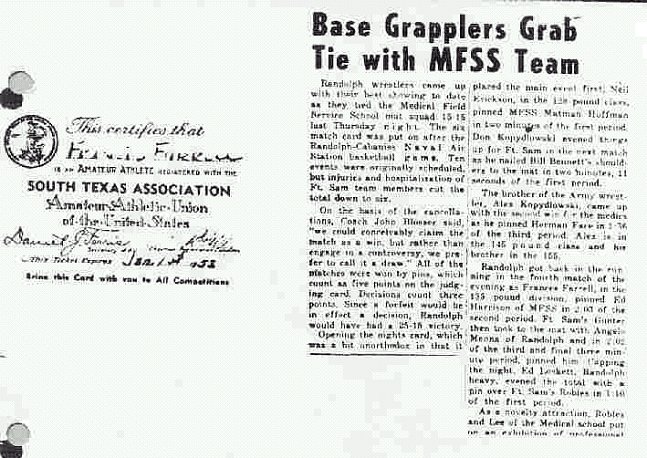
Fifty one years after the above article was written, I relocated Herm Face through an Internet White Pages search, simply listing "Herm Face - California", and finding him in Sun City near Riverside, and we have been corresponding since. Recent pictures provided by Herm and included in a later chapter, "OTHER REUNIONS", reflect that Herm may be as physically ready to go the Mats as he was in 1952!
We had a few problems with aircraft that had just recently been taken out of the "mothball fleet" at Pyote, Texas or from the "boneyard" at Davis - Monthan AFB in Tucson, Arizona, mostly new aircraft at the end of WW II but having not been operated in as many as 6 years! On one occasion at engine start, we had a # 1 engine blow a cylinder head off and through the cowling with a sheet of flame enveloping the whole engine ... and perhaps resulting in the fastest crew evacuation ever seen at Randolph ... looking like the circus car Chinese fire drill of dwarfs ! By the time I got out of the ship, the rest of the crew were standing and already smoking about 50 yards away, looking back ... at the fire crews surrounding the ship ... and laughing ... at Bob Gray our Navigator who had landed ON the middle of the back of our Instructor Pilot sprawled on the ground, having fallen in his jump out of the nose gear hatch. Whatever happened to the Captain being LAST to leave the ship? The I.P. was really mad and stood to the side of our crew as we laughed at Bob Grays "bailout" ... on top of him! All of these types of incidents became crew "legends", molding and melding the crew together ...
"We Band of Brothers"! There were more!
Lookin' back after engine explosion and crew evacuation!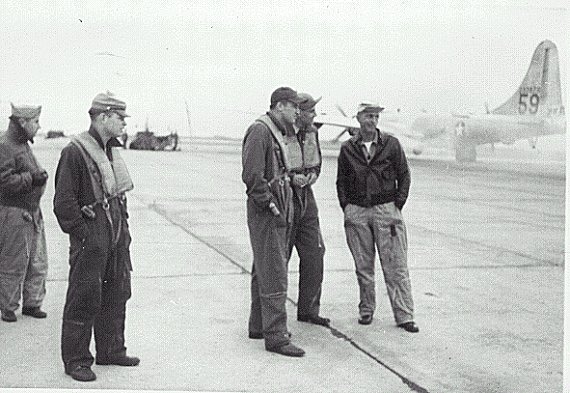
|
On a Saturday night training flight return, after about a nine hour flight, while passing by Beaumont Texas, and seeing The San Jacinto Battle Monument , well lighted and clearly visible from our relatively low letdown altitude just east of Houston, I dreamily thought of all the car headlights and people in them ... out to dinner ... dates ... going to the drivein ... whatever ... and wondered if any had looked up at us and wondered what WE were doing and where we were going ... .and I had the silly thought that wouldn't it be funny to bail out and float down in the middle of them ... land right at the circle around the Monument? In less than a minute after that daydreaming, we had a serious engine fire and received the three ring bailout alarm warning signal and my heart was in my throat ... "I'll land on a house ... or car roof or ... get run over!" Well, we extinguished the engine fire and scurried back into Randolph about 200 miles and an hour away ... and I thought my daydreaming had jinxed us!
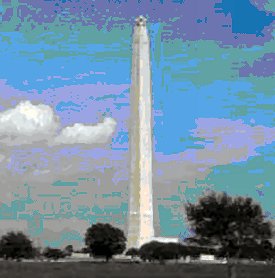
I was seldom casual or lackadaisical in many nights after this but I DID remember a boyhood incident of all too few years before that, that tickled my funnybone that night. A group of young teenagers were playing "tag" in the unfloored attic of the very large and sprawling Beddow House at the corner of Providence Rd and Woodlawn Ave in my hometown of Aldan, Pa ... .when Joey Kelly - nicknamed "Horse", "A Boy named Horse" - missed a rafter and fell between the rafters and through the plaster ceiling onto the Beddow's Grandmother's bed ... with her having breakfast in bed ... a very proper white haired dowager lady with little glasses etc, Joey landed next to her among the plaster, wire lathe ... and breakfast ... and she said "GOD DAMN YOU JOEY KELLY!" I often thought of "dropping in on someone" like that!
At the end of another day, March 12th, 1952 after a long flight, we heard that two B-29's had collided in mid-air near Randolph, with one of the aircraft apparently having set up an approach incorrectly in the always busy local traffic pattern ... 180 degrees out of direction, apparently with no crewmember, including an Instructor Pilot, realizing the mistake, nor seeing other aircraft in the racetrack pattern or flow of numerous other aircraft. Two crews, 15 crewmembers, were lost and a pall lain on the field for several days ... but the war in Korea continued as did the training of urgently required replacement combat crews! Sandy Kerner of our Gunnery School Class was among those killed in the crash and the first that made us really think about any vulnerability ... and no one talked about that or Sandy ... avoidance was denial! Philip Kauffman, also of our Gunnery School Class, took his boyhood / family / neighborhood friend home ... home to his family in New York City. This was perhaps the very first loss of a friend for many of us and had a very sobering effect on a lot of young kids now pondering what was in store for all of us?
And I recall no Randolph Memorial Services for either crew ... life and death go on! And the two parallel runways of Randolph, one on each side of the base, continued to have a constant flow of B-29's in two race track patterns, one with all right turns and the other all left turns ... but ALL starting in the same direction.
On March 18th we transferred from Randolph to Lake Charles AFB in Louisiana ... one year to the day of my "sendoff" and departing Philadelphia, we were leaving Texas, NEVER EVER to return ... or so I thought until a 1969 career transfer by my company and a 23 year "hitch" back and "deep in the heart of Texas" until 1992!
After our departure from Randolph Field we heard, but only many years later read about a modest rebellion of sorts at Randolph, a rash of "Fear Of Flying Cases" ... almost epidemic after the March 12th midair collision of the two B-29's mentioned previously, and just after our departure for Heavy Weigh Takeoff Training at Lake Charles AFB in Louisiana on March 18th. Apparently a further catalyst for a revolt of many recalled reservists, most of which had served very honorably in World War II combat, was when another Randolph Field Training Command B-29 and combat crew crashed near Seguin, Texas after a flat spin, with only the Instructor Pilot bailing out and surviving while the balance of the 11 man crew - and perhaps additional Instructors - were trapped by the high centrifugal forces created by the spin with all killed. By now we were to know of almost more B-29 crew member losses in training at Lowry AFB in Denver and at Randolph Field than we were to witness in our then forthcoming combat tour over North Korea!
Further research of this protest by several recalled reservist officers, and even a few enlisted rank volunteers withdrawing their voluntary flight status, indicated numerous personal concerns regarding what some believed were obsolete and even "war weary" B-29's being reactivated from the Davis-Monthan Air Force Base World War II mothball fleet, and being thrown into the fray of Korea with maintenance and technological weaknesses in the budding jet age and against the by now known formidable opponent in the MIG-15! Interestingly enough, there was also an element of flight personnel beyond B-29 crew - and in fact even some F-86 Pilots - who were very apprehensive about the new jets as still somewhat "experimental"! (Reference AMERICAN AIRPOWER STRATEGY IN KOREA by Conrad Crane).
Suffice it to say, "Ol' Iron Ass", Chief Of Staff of SAC, General Curtis LeMay, entered the controversy with threats of Courts Martial and Dishonorable Discharges and a major public relations effort by using the writer and film writer of TWELVE O'CLOCK HIGH, Beirne Lay, having him write and produce the movie THE STRATEGIC AIR COMMAND featuring Jimmy Stewart, the extremely popular moviestar, and more importantly, a real life hero of World War II having flown 35 combat missions over Europe as an 8th Air Force B-17 Squadron Commander. This sad but desperate moment at Randolph Field, and in the history of the newly formed separate Air Arm of the military, is NOT one of the brighter moments in the history of the U.S. Air Force OR of the vaunted B-29 Pacific Theater and Hiroshima/Nagasaki A-Bomb legacy ... but it would quickly recover with heroes named Jabara, Fisher, Lowe, Fernandez, Shields and Davis.
CHENEY'S CREW
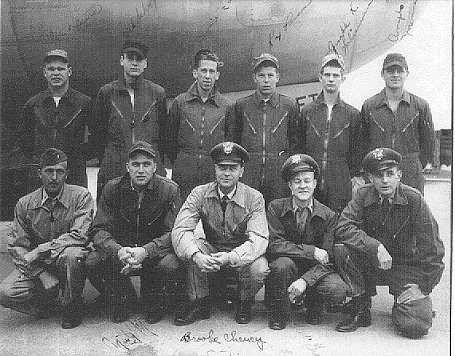
| ||||||||||||||||||||||
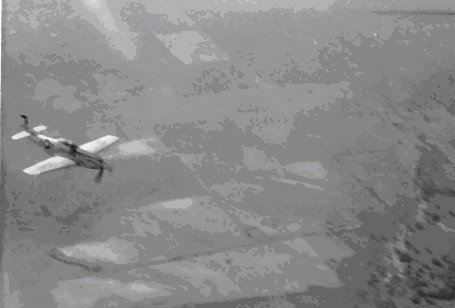
. - Farrell Photos -
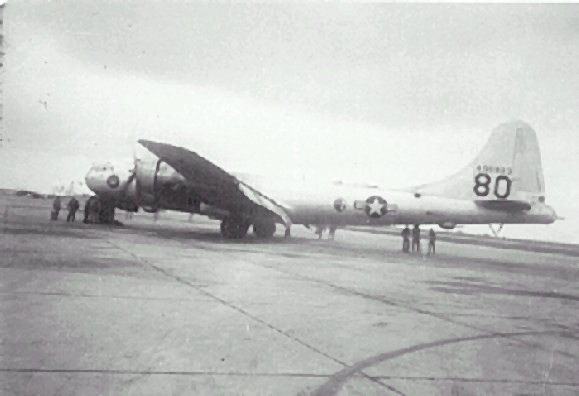
Floyd Gentry & Gunnery Instructor (on left) he got crewed up
with ... perhaps after the Instructor's tour with US!
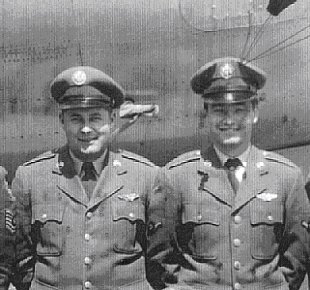
... and here is the Instructor (?) with our crew!
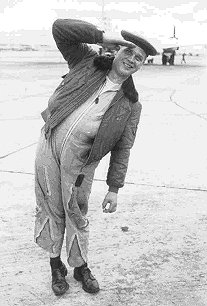
All Gunners were slightly "tilted'!
Note the low cut shoes, strictly prohibited
